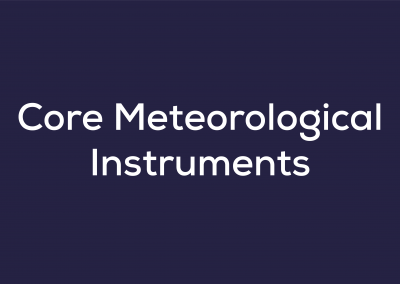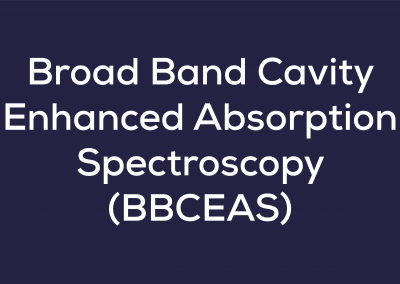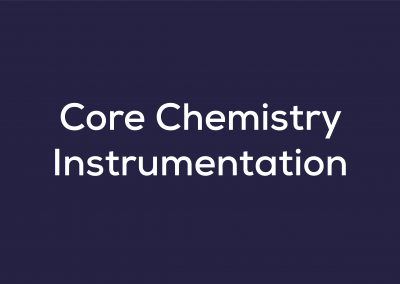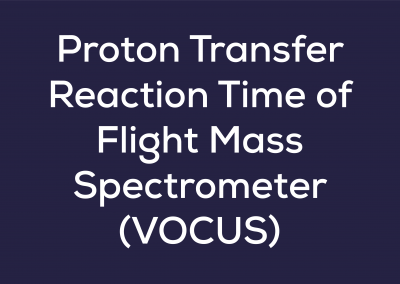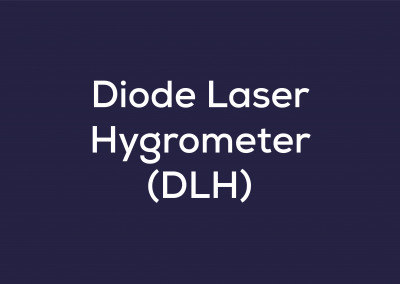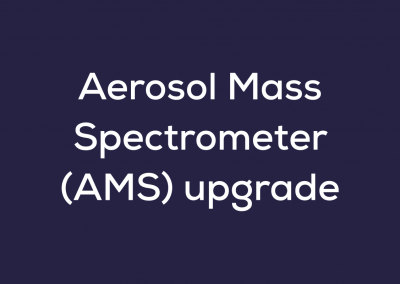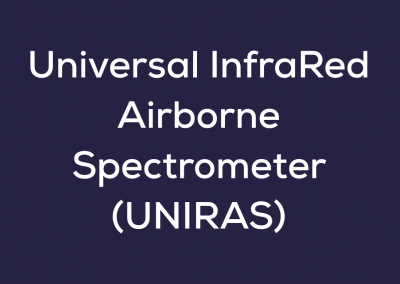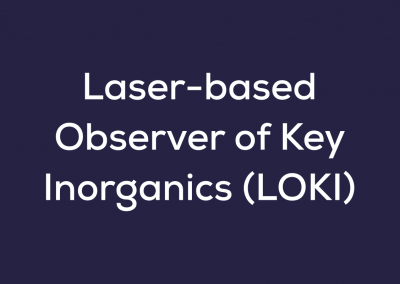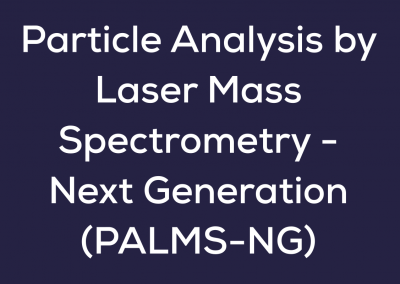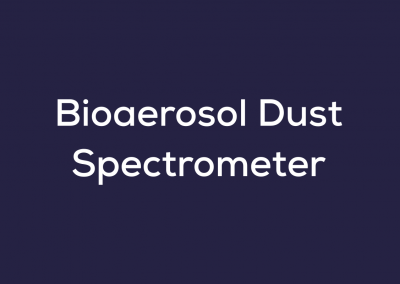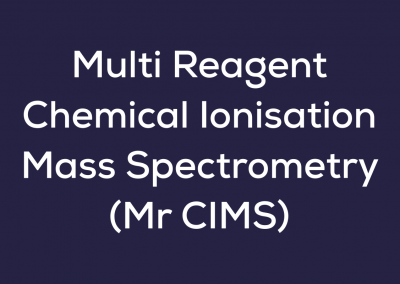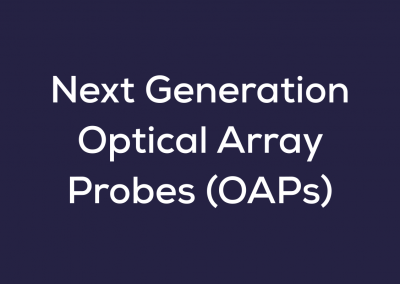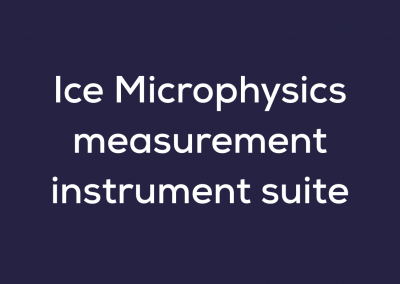Scientific instruments
The Mid-Life Upgrade will see a number of new instruments fitted to the aircraft as well as upgrades to existing ones, and the facility’s scientific measurement capabilities will improve significantly. Explore the instruments being developed using the filters below. New projects will be added as they complete the approval process.
The FAAM Airborne Laboratory takes many kinds of atmospheric measurements. You can read more about the atmospheric science we do in the menu below.
Aerosols
Why is it important to study aerosols?
Aerosols are microscopic particles which can be found floating in the air around us. Their sizes range from a few nanometers (literally just a handful of molecules stuck together) up to around a tenth of a millimetre. They fall into two broad categories; primary and secondary.
Primary aerosols are particles directly expelled into the atmosphere. They can be natural, such as pollen or dust blown from deserts or emitted from volcanoes, or they can be anthropogenic, such as soot particles from car exhausts or fires. Secondary aerosols are created in the air from certain trace gases. The gases that form these aerosols can also be natural, often emitted by plants and volcanoes, or anthropogenic, such as nitrogen or sulphur emitted by engines and power stations.
There are many important influences that aerosols have on the world around us. Inhaling aerosols can cause health problems; aerosols emitted from volcanoes are a hazard to aircraft; every water droplet in a cloud forms around an aerosol particle, meaning that aerosols affect cloud cover and rainfall; aerosols reflect and absorb sunlight affecting how the sun heats the planet. These processes affect our health, our weather and climate change.
How does FAAM measure aerosols?
FAAM uses multiple instruments to measure aerosol particles. Optical particle counters measure how individual particles scatter the light from a laser, allowing us to determine their size and concentration. Mass spectrometers blast aerosols apart, in a process known as ionisation, to measure their chemical constituents. Aethalometers measure how much light the aerosols absorb. A lidar shines a laser from the aircraft, to measure aerosol particles from a distance. FAAM also has instruments that expose aerosols to high relative humidities and freezing temperatures to investigate how aerosols encourage water droplets and ice crystals to form in clouds.
How will the Mid-Life Upgrade improve FAAM’s aerosol measurement capabilities?
As part of the FAAM Mid-Life Upgrade, we will be replacing older instruments with newer, more reliable and more capable state of the art instruments. We will also be adding to our capabilities. A new instrument will shine intense laser light at particles, causing pollen, fungal spores and airborne bacteria to glow with ultraviolet light and be separated from other non-biological particles.
One of the biggest challenges in this field is getting the aerosol samples to the instruments. Because the FAAM aircraft is flying through the air at over 200 mph, the larger aerosol particles can be excessively rammed into forward facing inlets or whizz past sideways facing inlets. These factors cause biases in our measurements and a full upgrade of the sampling system is being conducted as part of the Mid-Life Upgrade.
Atmospheric Chemistry
The Mid-Life Upgrade programme will further develop the world-leading gas phase chemistry monitoring capability on board the FAAM Airborne Laboratory’s research aircraft. Investment in a range of atmospheric chemistry instrumentation will enable scientists to investigate scientific challenges related to climate change, air quality and the ozone layer.
Why is it important to study atmospheric chemistry?
Understanding the source and magnitude of emissions of gases to the atmosphere is vital for predicting current and future atmospheric composition. Once gases are emitted to the atmosphere, the majority undergo chemical reactions and processing that can lead to the formation of other, potentially harmful, secondary species. The hydroxyl radical OH is very important in this process, as it reacts rapidly with the majority of chemicals. FAAM will be able to measure OH, allowing a comparison to be made with model calculations, which will improve understanding of atmospheric chemical reactions. Also key to the chemical reactions are levels of nitrogen oxides, which can vary from a few parts per trillion over the remote ocean, to hundreds of parts per billion in large cities.
How will the Mid-Life Upgrade improve FAAM’s atmospheric chemistry measurement capabilities?
The work carried out through the Mid-Life Upgrade will enhance FAAM’s world-leading capabilities. The aircraft will carry a suite of mass spectrometric instruments that will be capable of making in-situ and high-resolution measurements of thousands of chemical compounds. These include:
- volatile organic compounds that come from sources such as cities, wildfires and forests and play a significant role in the formation of secondary pollutants such as tropospheric ozone and organic aerosols.
- halogenated compounds that have both natural and human sources, which can affect stratospheric ozone levels.
- natural and human-derived emissions of methane and nitrogen oxides, which are currently not well understood but have important impacts on air quality and climate change
As a result, an archive of measurement data will become available for retrospective analyses of as-yet-unidentified chemical compounds.
Cloud Physics
The Mid-Life Upgrade replaces current cloud microphysics instrumentation with updated and new state-of-the-art instruments, significantly enhancing FAAM’s cloud measurement capability. The facility will retain its world leading reputation in this area and provide a UK platform that can address the fundamental uncertainties in the field of cloud physics.
Why is it important to study cloud physics?
Measuring an array of cloud microphysical processes will enable scientists to better understand processes such as how ice in mixed phase clouds develops through primary nucleation and Secondary Ice Production (SIP); the nature of the fine scale structure of liquid/ice in mixed phase clouds; and the development of precipitation. This understanding will lead to improvements in climate and regional forecast models, ultimately improving future weather forecasts and climate change predictions.
However, making many of these cloud measurements requires high resolution, fast response in-situ cloud particle imaging instruments. Currently no single instrument can deliver this range of measurements so a combination of instruments and integrated measurement techniques is needed.
How will the Mid-Life Upgrade improve FAAM’s cloud physics measurement capabilities?
The former suite of FAAM core in-situ cloud microphysics instruments will be replaced by a collection of new fast, state of the art cloud probes, including shadow imaging optical array probes.
A new suite of state-of-the-art research-grade instruments has also been funded as part of the “Ice Microphysics” proposal. Using new stereo image analysis techniques will help to reduce the uncertainty in cloud and precipitation particle measurements by eliminating many of the mis-sized, out-of-focus particles previously included. We are replacing the previous 3-View Cloud Particle Imager. A UK holographic cloud spectrometer probe will be installed and is essential for identifying mechanisms involved in SIP and first ice formation processes. The MLU has also funded work to develop next generation optical array probes, significantly increasing certainty in measured cloud data and potentially collecting data on as-yet-unobserved processes in cloud formation.
Remotely measuring cloud properties by radar and lidar techniques prior to flying in the clouds to measure their in-situ cloud properties is another exciting development being supported by the MLU. This will allow detailed small scale in-situ measurements to be put into context within the larger-scale cloud or multiple cloud environments. This is another area of new capability that brings the FAAM aircraft up to the specification of the very best airborne measurement platforms worldwide.
Core Meteorology
Measuring meteorological conditions (including weather) is a fundamental part of atmospheric science, and is a key aspect of the FAAM Airborne Laboratory’s capabilities. The Mid-Life Upgrade sees this capability upgraded, providing data that will help develop the next generation of climate and weather models.
Why is it important to study meteorology?
The context provided by meteorological data is crucial for understanding other aspects of atmospheric science such as chemical processes, whose rates may depend on temperature and other conditions. FAAM also provides validation of measurements for data gathered from other platforms. Validating and calibrating satellite or ground-based sensors, or offering guidance during the development of new space-borne instruments is an important function of the facility.
How does FAAM measure meteorology?
The FAAM Airborne Laboratory routinely makes in-situ measurements of temperature, pressure, humidity and winds at fine scales, taking readings every 3-5 metres. Understanding the atmosphere at this fine detail is becoming of greater importance as weather and climate forecast models become more capable. These modern computer simulation systems now represent the atmosphere at greater levels of detail (resolution) and complexity (more processes, including resolved clouds, chemistry and air quality) and need environmental observations to allow them to be validated and developed.
How will the Mid-Life Upgrade improve FAAM’s meteorology measurement capabilities?
The move to higher-resolution atmospheric modelling systems brings with it the need for new sensing systems. Improvements will be made to the basic pressure, temperature and wind sensing systems onboard the aircraft. Modern sensing elements and state-of-the art digital acquisition systems will provide a step-change in capability, through higher-resolution data, better signal-to-noise ratios and more resilience to challenging atmospheric conditions.
Through the Mid-Life Upgrade we are exploring the possibility of developing and installing a Doppler Wind-Lidar to allow the measurement of winds and turbulence structures in the air column beneath the aircraft as it flies. This would allow FAAM to provide new capability with which to develop and test the next generation of high-resolution weather forecast models. A separate project aims to build a new instrument capable of measuring temperature, and hence the buoyancy of the air, within clouds. This is notoriously challenging as wet conditions inside clouds is a challenge for traditional temperature sensors, through evaporative cooling. Radiometric techniques would bypass the need to account for cooling of sensors due to the moisture in clouds.
Radiation and Remote Sensing
Why is it important to study radiation?
In order to determine the Earth’s energy budget (how much energy the Earth receives from the sun versus how much energy is lost to space) and assess the factors controlling climate and weather, scientists need to understand how the radiation present in the atmosphere interacts with atmospheric gases, particles and clouds. By observing radiation at different wavelengths, we can identify and quantify this interaction.
How does FAAM measure radiation?
The new and existing radiation and remote sensing instruments on board FAAM provide coverage of the electromagnetic (EM) spectrum from the ultraviolet to microwave regions. The suite of instruments include downward-facing and upward-facing apertures for a range of viewing capabilities, as well as the ability to measure angularly-resolved or spatially-resolved radiances at selected wavelengths. The instruments provide a range of spectral resolutions as well as broadband radiation measurements.
How will the Mid-Life Upgrade improve FAAM’s radiation measurement & remote sensing capabilities?
Simultaneous radiation measurements across the entire EM spectrum allows us to determine the full radiative effect of different atmospheric components. Through the Mid-Life Upgrade, FAAM remains the only research aircraft capable of measuring the EM spectrum across the far-infrared, a region which is highly sensitive to upper troposphere-lower stratosphere water vapour and permits longwave radiative closure. The instruments provide key atmospheric measurements of liquid water content, aerosol optical depth, surface and brightness temperature, and emissivity (how effectively a surface emits thermal radiation). A number of the radiation instruments will act as airborne demonstrators for comparison to satellite observations and can be used to help to develop and validate retrieval schemes under different atmospheric conditions.
The radiation and remote sensing instrument suite provides data on aerosol types (such as dust and volcanic ash) and aerosol optical properties and can provide trace greenhouse gas column concentrations for species such as water vapour, ozone and methane. It can identify different cloud types present (e.g. stratus and cirrus clouds) and their properties such as ice-containing or liquid-containing particles and their altitude, all of which have important impacts on weather and climate predictions.
Infrastructure Projects
Learn more about the MLU’s infrastructure projects.


